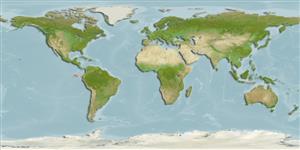>
Gadiformes (Cods) >
Macrouridae (Grenadiers or rattails)
Etymology: Nezumia: A Japanese word that means "mouse".
More on author: Garman.
Environment: milieu / climate zone / Tiefenbereich / distribution range
Ökologie
seewasser bathydemersal; standorttreu; tiefenbereich 600 - 1500 m (Ref. 1371). Deep-water; 3°N - 43°S, 114°E - 71°W (Ref. 1371)
Eastern Indian Ocean: temperate Australia. Southeast Pacific: Galapagos Islands and off central Chile. Two subspecies are recognized, Nezumia loricata loricata from the Galapagos and Nezumia loricata atomos from Chile. The Chilean and Australian records suggest a broad temperate distribution across South Pacific.
Size / Gewicht / Alter
Geschlechtsreife: Lm ? range ? - ? cm
Max length : 30.0 cm TL Männchen/unbestimmt; (Ref. 1371)
Kurzbeschreibung
Bestimmungsschlüssel | Morphologie | Morphometrie
Rückenflossenstacheln (insgesamt) : 2; Afterflossenstacheln: 0. Head with strongly developed, angular suborbital ridge; snout moderately pointed, with spiny tubercular scale at its tip and lateral angles. Underside of snout and part of the suborbital region naked; mandibles covered with small deciduous scales. Pyloric caeca 20 to 32. Body scales adherent, with dagger-shaped to narrowly triangular spinules in somewhat convergent rows. Anus is closer to the origin of the pelvic fins than to that of the anal fin. Overall color is swarthy to medium brown, darker ventrally; fins blackish; mouth dusky.
Body shape (shape guide): elongated; Cross section: oval.
Life cycle and mating behavior
Geschlechtsreife | Fortpflanzung | Ablaichen | Eier | Fecundity | Larven
Cohen, D.M., T. Inada, T. Iwamoto and N. Scialabba, 1990. FAO species catalogue. Vol. 10. Gadiform fishes of the world (Order Gadiformes). An annotated and illustrated catalogue of cods, hakes, grenadiers and other gadiform fishes known to date. FAO Fish. Synop. 125(10). Rome: FAO. 442 p. (Ref. 1371)
IUCN Rote Liste Status (Ref. 130435: Version 2025-1)
Bedrohung für Menschen
Harmless
Nutzung durch Menschen
Fischereien: weniger kommerziell
Tools
Zusatzinformationen
Download XML
Internet Quellen
Estimates based on models
Preferred temperature (Ref.
123201): 4.6 - 5.4, mean 5.2 °C (based on 16 cells).
Phylogenetic diversity index (Ref.
82804): PD
50 = 0.5000 [Uniqueness, from 0.5 = low to 2.0 = high].
Bayesian length-weight: a=0.00214 (0.00109 - 0.00421), b=3.20 (3.03 - 3.37), in cm total length, based on LWR estimates for this (Sub)family-body shape (Ref.
93245).
Trophic level (Ref.
69278): 3.3 ±0.1 se; based on size and trophs of closest relatives
Widerstandsfähigkeit (Ref.
120179): mittel, Verdopplung der Population dauert 1,4 - 4,4 Jahre. (Preliminary K or Fecundity.).
Fishing Vulnerability (Ref.
59153): Low vulnerability (20 of 100).
🛈
